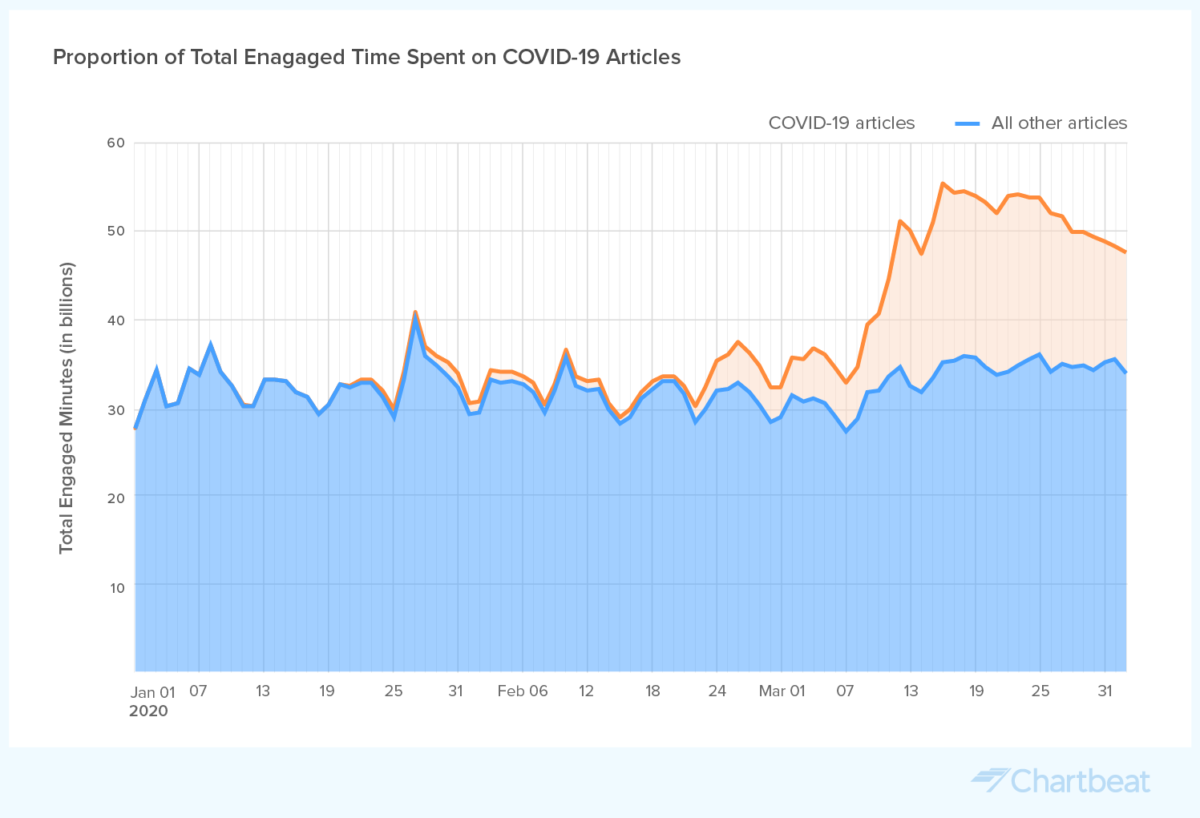
Some parts of America seem to be having — early, tentative, potential — success flattening the curve of COVID-19 infections. But there’s one place where the curve has already gone flat: traffic to news sites. Last month’s striking surge in audience attention has ebbed week by week and has now largely washed away. Here’s what that looks like:

Let’s march down the timeline.
By March 9, 1 of every 4 pageviews on a U.S. news site was on a coronavirus story, and the topic was generating the sort of attention in a week that the impeachment of Donald Trump did in a month. That’s according to data from Taboola’s Newsroom network of sites.
Articles about coronavirus accounted for nearly a quarter of all US news page views in the past 7 days.
We saw 278M PVs on the @taboola network of news publishers. For context, we saw 250M on impeachment stories in all of January and 167M about the Super Bowl in Jan & Feb. pic.twitter.com/7DBmGc1fd9
— Fran Berkman (@FranBerkman) March 9, 2020
Globally, we're seeing weekly traffic highs. Average PVs for the past week for Newsroom users was 25% above the mean.
Where are readers coming from? Direct (includes dark social) has been on the rise since the beginning of last month despite a slight regression the past week. pic.twitter.com/daY7tpIsF7
— Fran Berkman (@FranBerkman) March 16, 2020
Traffic seemed to peak around March 12 and 13; that’s the period immediately following Donald Trump’s Oval Office address, Tom Hanks’ diagnosis, and the suspension of the NBA. The analytics firm Parse.ly noted that total traffic to news sites on March 12, a Thursday, was nearly double the average of the previous six Thursdays.
Audience attention then stayed pretty steady through March 23, as noted in this data from Chartbeat:

But then the air began leaking out of that balloon. Attention to coronavirus news had already begun to ebb by the end of March — again, data from Chartbeat (in a post warning of “coronavirus fatigue”):

And Taboola:
It seems readership may have reached saturation point last week. We're seeing significantly lower daily PV totals this week (175-185B vs 200-250B per day). pic.twitter.com/r74cRWhkUW
— Fran Berkman (@FranBerkman) April 2, 2020
Attention dipped further in the first week of April:
Update: US news traffic to coronavirus articles declined last week for the first time since it took off one month ago. Page views dropped from 1.4B to 1.1B.
Covid 19 article traffic grew by nearly 100M PVs, so part of the coronavirus drop may be due to shifting terminology. pic.twitter.com/HO1zOxg420
— Fran Berkman (@FranBerkman) April 6, 2020
And as of right now, news traffic to news sites, both in the U.S. and around the world, is pretty much back to pre-coronavirus levels in Taboola’s data. Last week was a “good normal” week, audience-wise, not a “wow” week. Here’s the key chart:

News website traffic is quickly returning to normal. Compared to a 6-month, pre-corona average, traffic was up just 7% globally and 13% in the US last week.
The peaks were +41% globally and +52% for the US. pic.twitter.com/SLVknE75AB
— Fran Berkman (@FranBerkman) April 13, 2020
If you add together articles referencing both “coronavirus” and “covid” (to reflect the shift in usage toward COVID-19) in Taboola’s data, you get something roughly like this:
March 9: 300 million
March 16: 1.13 billion
March 23: 1.68 billion
March 30: 1.67 billion
April 6: 1.478 billion
April 13: 980 million
Here’s some Parse.ly data pulled together by the company’s data insights lead, Kelsey Arendt; check out the decline in traffic specifically to coronavirus content (first chart) and to news sites overall (second chart).


Arendt notes that, while there has been a substantial decline in attention, “overall traffic is still quite high, relatively speaking.” Which certainly seems true in Parse.ly’s universe of sites.
(Side note: Each of these content-analytics companies works with somewhat different sets of publishers and uses somewhat different methodologies and metrics, so it’s not surprising there are differences. For example, coronavirus traffic makes up a notably smaller portion of total news traffic the way Parse.ly measures it than does for Chartbeat or Taboola. Coronavirus traffic peaked at 15 percent of total news traffic for Parse.ly, 35 percent for Chartbeat, and 54 percent for Taboola — and again, each is measuring a slightly different thing.)
But the trend line is consistent across the board: The explosion of traffic to news sites in mid-March was a spike, not a leveling-up to a new baseline. Interest in coronavirus news has fallen substantially. The “new normal” has indeed become, well, kinda normal.
This could all change tomorrow, of course. At any moment, some giant new COVID-19 shock could refocus the world’s attention.
But this is a pattern we’ve seen before, on subjects as different as Donald Trump’s various violations of presidential norms and climate change: Sustained attention is hard to maintain over time, no matter how objectively important a topic might be. The lives of nearly every American (and, of course, billions elsewhere) are now starkly different than they were a couple months ago — but their interest in news has rapidly regressed toward the mean.
Figuring out how to maintain that interest — and to spark more of it when necessary — will be an important challenge not only for the news business, but for society at large.